The conservator for Our Lady of Piety, Sheila Payaqui, head of Sculpture and Decorative Arts Conservation at VMFA, says that this work was the most challenging one she has had. This was due to the complexity of the piece and the extent of the damage. The layer of grime covering the piece had to be gently removed; reattaching the dislodged decorative elements proved to be an extensive process; and replacement rays had to be made to fit their spots perfectly.
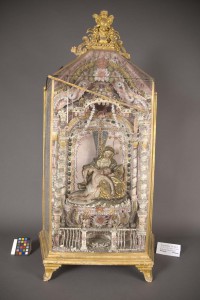
Our Lady of Piety Oratory
Damage from Travel
VMFA Photo Resources
The level of dirt and grime covering the oratory was extreme and required extensive cleaning. However, the delicacy of the components required gentle methods and research before starting the process. First, solvents had to be tested to ensure that no damage would be done to the work during cleaning. Then, once the correct solvent was identified, the solvent and a small vacuum, which was attached to a rheostat to monitor the level of suction, were used to clean all the small pieces and crevices of the work.
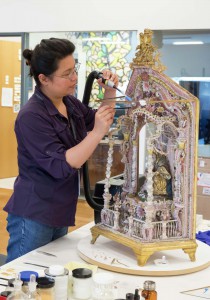
Photo: David Stover © Virginia Museum of Fine Arts
Sheila Payaqui, Associate Conservator, Sculpture and Decorative Arts Conservation, working on the sculpture: Our Lady of Piety.
After cleaning, it became evident that many of the pieces had originally been painted with watercolor to increase their luminosity. In order to keep the look of the piece cohesive, the conservator and curator made the decision to correct any watercolor loss that was found during cleaning. This had to be done with delicacy and precision.
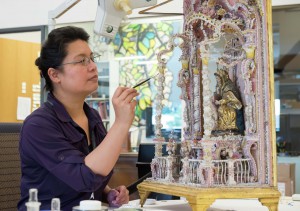
Photo: David Stover © Virginia Museum of Fine Arts
Sheila Payaqui, Associate Conservator, Sculpture and Decorative Arts Conservation, working on the sculpture: Our Lady of Piety.
One of the most challenging portions of the conservation process was the reattachment of all the small, ornamental shell pieces. Part of the problem was simply their sheer number. Another factor that worked against time was the damage to the ornamentation. Many of the detached pieces were tiny and looked alike. Some were missing bits, which meant they no longer fit in their original locations. The first step was the categorization and organization of all the pieces. This made the fitting and reattaching easier and simpler. The size of the pieces made this process very difficult. The conservator had to wear magnifying glasses and use tweezers to handle and place the dislodged elements.
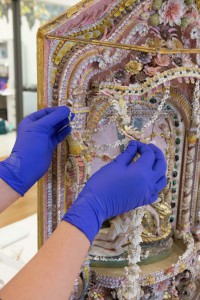
Photo: David Stover © Virginia Museum of Fine Arts
Sheila Payaqui, Associate Conservator, Sculpture and Decorative Arts Conservation, working on the sculpture: Our Lady of Piety.
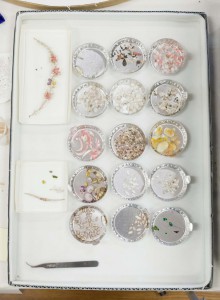
Photo: David Stover © Virginia Museum of Fine Arts
Sheila Payaqui, Associate Conservator, Sculpture and Decorative Arts Conservation, working on the sculpture: Our Lady of Piety.
The missing rays behind the Pietà figure group created a physical challenge in correcting the loss and also raised the question of how far conservation should go. Would it be better to leave the two remaining rays and the empty space around them, or to replace the missing rays? Which approach would be the more authentic outcome? Would the work be more authentic if it were displayed with only original parts and were missing some pieces? Or would the work be more authentic if it were displayed as it would have looked when it was made? These questions are relevant in all conservation efforts that include missing pieces or altered works. For this oratory, the decision was made to replace the rays. Without the rays, some of the drama surrounding the Pietà would be lost and the overall emotional impact of the piece would be lessened as well. The replacement rays had to be made exactly like the original pieces to fit in the total composition. This was done by making a mold and creating them out of a conservation-grade epoxy that imitates glass. The addition of the rays was done with materials that could be reversed in the case that later conservation efforts found better methods of replacing them or if future generations wanted to see the piece without those replacement pieces.
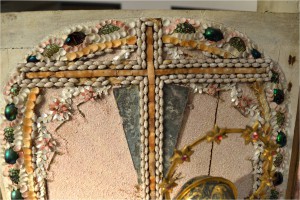
Our Lady of Piety
Brazilian Oratory
Missing Metal Rays
VMFA Photo Resources
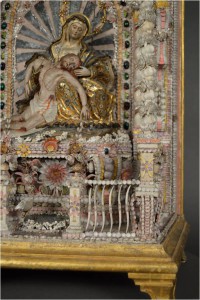
Our Lady of Piety
Brazilian Oratory
Added rays
VMFA Photo Resources
The process of conservation does not stop once the piece is on display. It has to be displayed in a way that ensures that the conservation efforts will not be reversed by time and that there will not be further damage to the piece. For Our Lady of Piety the greatest technical challenge in display was the beetles incorporated into the decoration. They have an iridescent quality and this would be lost if put under bright light for an extended amount of time.
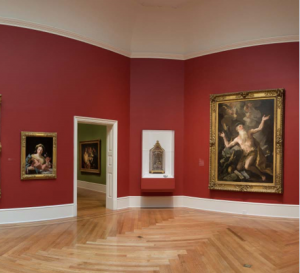
Image of Oratory in Gallery
Learning More From VMFA Conservator, Sheila Payaqui
Links to Other Pages
Brazilian Oratory: Baroque, Rococo, and Local Influences
Brazilian Oratory: Notes on Brazilian History
Our Lady of Piety Oratory: The Influence of European Religion on South America
Our Lady of Piety Oratory: Condition through the Years
Our Lady of Piety Oratory: Conservation
The Story of How the Beetle got its Colors